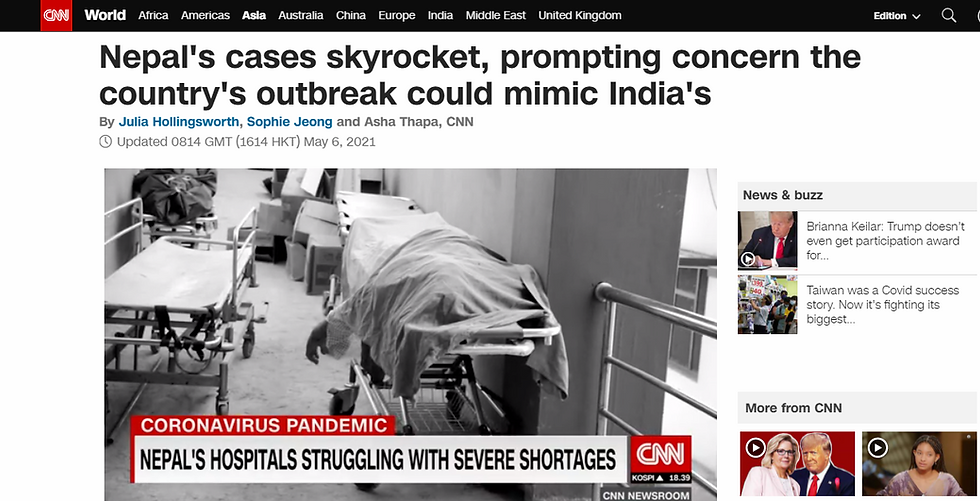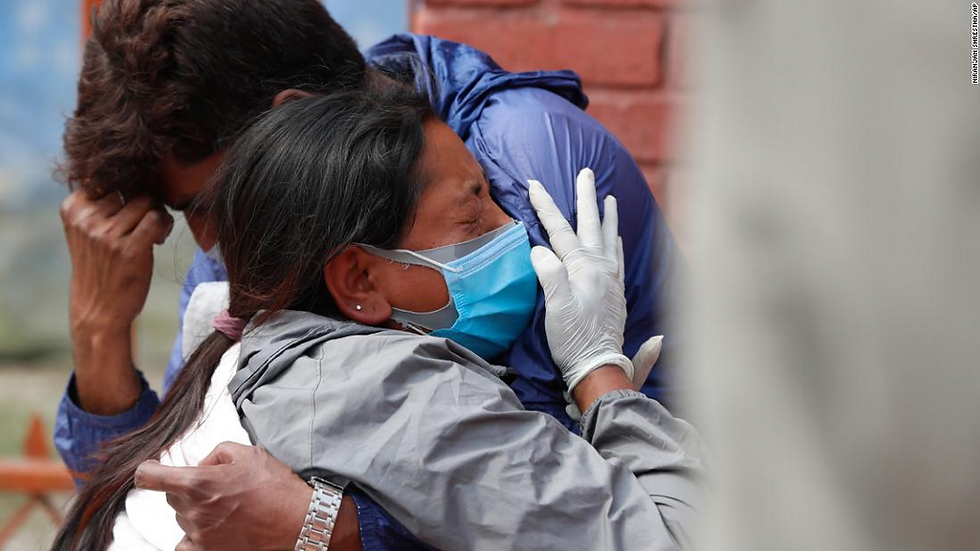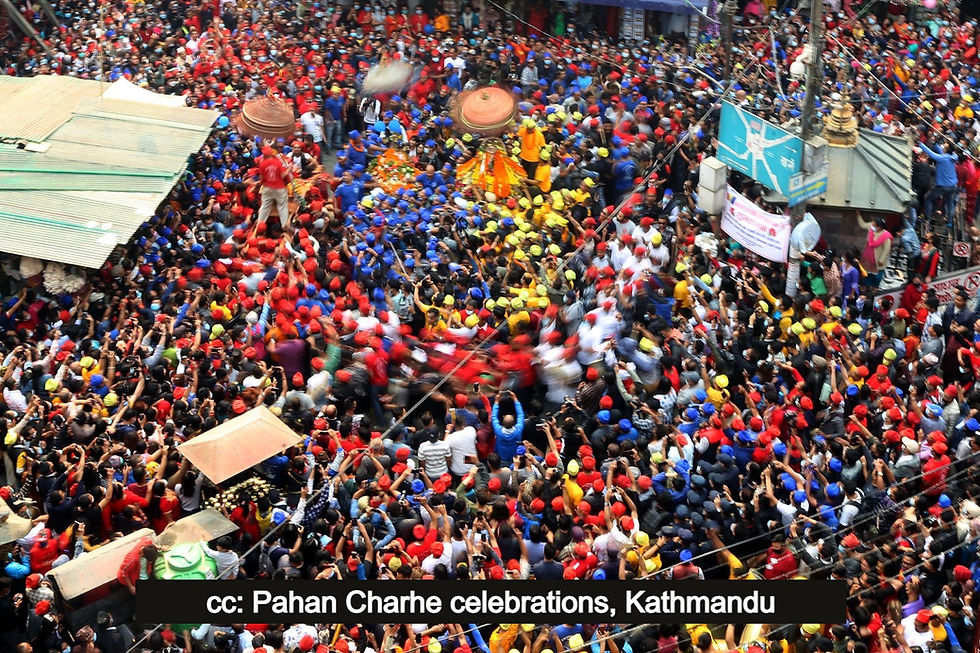Having administered enough vaccine doses for barely vaccinating 5% of the population, 45% positivity rate of Covid19 patients, 1200% surge in cases and about a total of 4.7 Lakh cases with about 5500 deaths, Nepal is quickly becoming one of the worst hit countries in the Covid-19 crisis.
If these numbers aren’t staggering enough, Nepal is facing this catastrophe with a dwindled leadership as the country is amidst a political crisis at the same time.
Nepal is now seeing the fastest spread of the COVID-19 virus on the planet. Health experts warn that the worst is yet to come.
Donation Links- You can try to do your bit by donating to the following funds:
www.karuna.org - Fundraising + donating for international relief to the COVID crisis.
Global Giving Nepal Pledge - Emergency COVID-19 fundraiser for Nepal
Give2Asia Fund - Covid-19 response fund
https://www.nepalitimes.com/here-now/important-covid-helpers/ = A list of COVID resources for Nepal
America Nepal Medical Foundation is setting up isolation centres in Kathmandu. Donation details here.
Feed the Hungry Nepal is arranging for food supplies to those who need it, as well as oxygen cylinders. Donation details on Facebook.
100’s group has been making oxygen cylinders available and getting them to Covid patients. Find information on where to donate and whom to contact on Facebook.
UK-based Our Sansar are running a matched giving appeal through funding platform The Big Give to raise Covid funds for rural Nepal until 13 May. Pipal Tree will take over the appeal after 13 May. Donate here.
https://covidconnectnp.org/ To offer help or inquire for healthcare resources.
https://nepalrising.org/covid-wave2 - Direct link to Donation to Nepal Rising
What is the Crisis?

With the second wave in India, many people are blaming this surge in Nepal on the mobility of workers from the border of India to Nepal. Earlier, Nepal recorded less than 100 cases daily which has now increased to a daily average of 9000+

In a few words, the healthcare infrastructure of Nepal has collapsed and is insufficient to deal with this humanitarian crisis. According to the government's Covid-19 response plan from last May, the country only has 1,595 intensive care beds and 480 ventilators for its about 30 million people. It also has a shortage of doctors, with just 0.7 physicians per 100,000 people, according to World Bank data. Now, no ICU beds and oxygen cylinders are left in the country. Hospitals are overburdened with patients and are compelled to turn away patients.

"If we don't manage this right now, the situation will become catastrophic," said Dr Samir Kumar Adhikari, the chief of the government's Health Emergency Operation Centre. "In Kathmandu valley, almost all of the intensive care beds and ventilators are full," he said. "Even in hospitals where beds are available, they cannot admit patients due to a lack of oxygen. We have also run out of vaccines."
“There are no ventilators. There aren’t enough masks or protective wear for nurses and there certainly are not enough doctors and nurses here to deal with this.” - Niko Ruwe, an American living in Nepal
“People are coming home because there’s nowhere to go and it’s not necessarily safe,” Christie Getman, Mercy Corps’ Nepal country director.
How did they reach here?
1. Public Gatherings
This crisis began in early April, as PM Oli had suggested another unproven remedy to cure COVID by chewing guava leaves. Later that month began a series of religious gatherings. Nepali devotees joined Hindus who bathed in the Ganges for Kumbh Mela, one of the world's biggest religious gatherings. These included Nepal's former and Queen, who had to be admitted for COVID care on their return. Around the same time, thousands of Nepalis gathered in Kathmandu to celebrate Pahan Charhe. Others came together to celebrate Bisket Jatra, despite authorities ordering them not to, according to local media. One placard in support of the event read: "Our festival is dearer than our lives to us." "Some festivals are coming up during this prohibitory period as well, but the government is not in the condition to say anything," Gautam said, adding that the situation is now in the hands of the Nepali people. We are tired of telling people to follow the safety measures."

On April 24, when the country reported more than 2,400 new cases, Oli collected a media crowd as he inaugurated a new Dharahara, to replace a tower destroyed in the deadly 2015 earthquake.
2. Fatal healthcare system
Providing quality health care during the COVID-19 pandemic has been challenging and such care is limited to only a few people. Nepal faces more challenges in providing health care services than developed countries. In the context of Nepal, factors such as poverty, illiteracy, lack of infrastructure, shortage of health care professionals, attitude towards medical professionals, security concerns of health care professionals, health insurance policies, geographic distribution, culture, governmental policies, and physical barriers also directly affect health care services being provided.
What can be amended in the healthcare infrastructure?
There are lessons to be learned from countries like Italy, which was severely affected by the current COVID-19 pandemic. Governments can act appropriately if they adopt certain suggestions:
First, health care systems’ capacity and financing need to be more flexible to take into account exceptional emergencies.
Second, in response to emergencies, solid partnerships between private and public sectors and the government should be institutionalised.
Third, the recruitment of health care workers and other human resources must be planned and financed according to a long-term vision.
Fourth, decentralisation of health care institutions throughout the country and mutual coordination between the health ministry and its divisions should be established. Consistent management choices and a strong political commitment are needed to create a more sustainable system.
The best health services can be received and given only when the relationships between patient, doctors, health professionals, health care institute and the government are run with mutual coordination and understanding.
PM Oli pleading for International help
Prime Minister Khadga Prasad Sharma Oli and other leaders mired themselves in a political crisis that distracted precious attention away from COVID-19. In February, the Supreme Court ruled Oli’s move unconstitutional and reinstated Parliament. Oli lost a vote of confidence in Parliament on May 10, but nonetheless appears set to retain power in the near term. If Oli loses the second confidence vote new elections can be called — but those would probably be postponed due to the health crisis, further extending Oli’s tenure.
Addressing the international community PM K.P. Sharma Oli said “Despite our utmost effort, the second wave of COVID-19 has severely hit the country with a surge of infections and mortality rate. I’m aware that this invisible enemy has tested our ability and exposed our vulnerability globally but I do believe that this deadly disease can be overcome through our collective efforts. Since we are living in an interconnected and interlinked world, a pandemic like this spares no one and no one is safe. I would like to address our neighbours, friendly countries and international organisations to help us with vaccines, diagnostic equipment and kits, oxygen therapy, critical care medicines and furniture to support our ongoing efforts to combat the pandemic.”
Indian Assistance
In January, India donated 1 million AstraZeneca-Covishield doses to Nepal who soon after signed a deal to purchase additional 2 million doses from the SII. India’s provision of those vaccines helped ameliorate its relationship with Nepal, which deteriorated after a border dispute in early 2020. However, India halted vaccine exports in late March to ensure inoculations for its own citizens as the virus began to rage. As a result, Nepal received only half of the 2 million doses it ordered.
What can be done?
With soaring COVID-19 cases and a laggard vaccination rate, Nepal now has the fastest spread of cases on the globe. Accompanying these are the shaken healthcare facilities overwhelmed due to the acute shortage of hospital beds, ventilators, vaccines , oxygen and doctors. The country is at a standstill requesting international help. Immediately.
Foreign grants and aid with technical support can be helpful. ~ Somya Maan

Good